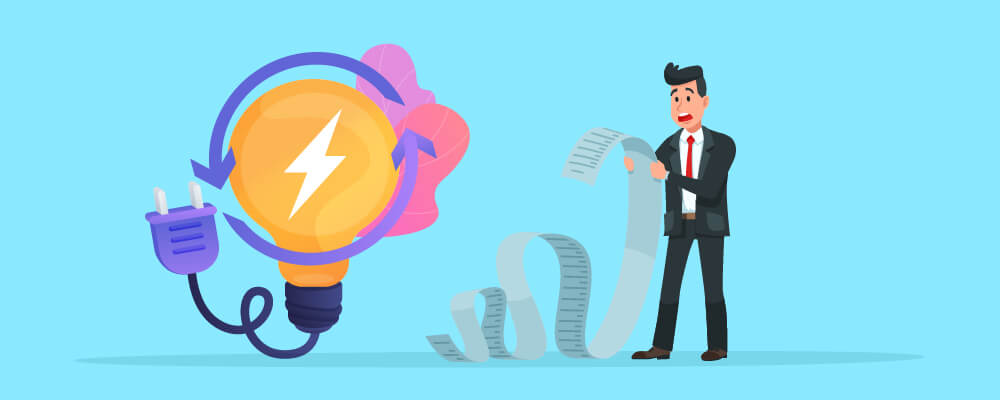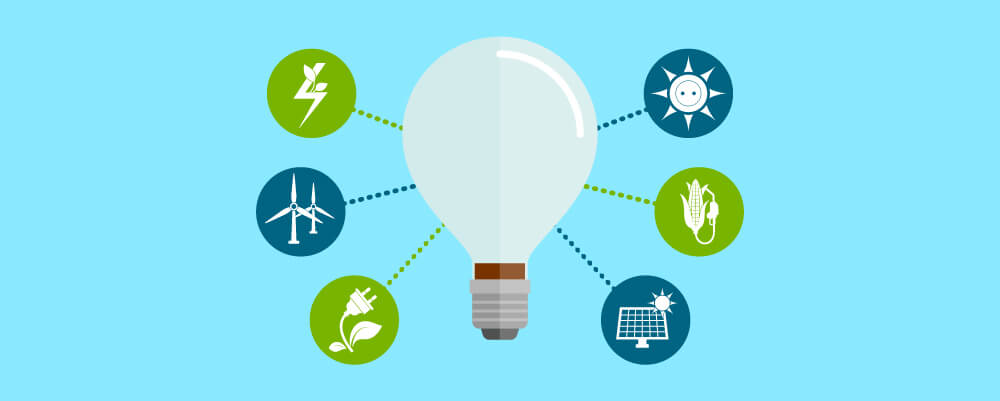The Complete Guide to Saving Money on Your Energy Bills
Save money on your energy bills without sacrificing comfort.
Thanks to the raging pandemic, geopolitical tensions, and the supply chain crisis, our energy bills at the end of 2021 were roughly 20% higher than the year before.
That’s right — the average standard variable tariff will now set you back £1,277 per year. And if you think that opting for a fixed tariff will bring this number down — as it normally would — think again: the average fixed tariff is only £9 cheaper, at £1,268.

This unprecedented rise in gas prices has sparked a flurry of permanent closures among the nation’s smaller, more affordable energy companies. If you’re unlucky enough to be the customer of a doomed energy supplier, your tariff will be transferred over to one of the Big 6 companies — which typically get away with charging above average.
What’s more, fewer available suppliers ultimately means that the consumer has few affordable tariff options from which to choose.
Unfortunately, we have zero control over the powers that have conspired to drive our energy bills skyward. But luckily, there are things we can do to slash our energy consumption in a meaningful way and shave a good chunk of money off our heating and electricity bills.

In this article, we have 18 tips that can help you do just that. Read on to learn more!
How Much Energy Does an Average Household Use?

According to the nation’s energy regulator (Ofgem), the average British household consumes 14,900 kWh of energy every year — 2,900kWh of electricity and 12,000 kWh of gas. For context, the average electric car uses 2,000 kWh every year.
Home heating costs account for over half of the 14,900 kWh total, with hot water and appliances following closely behind. If you were able to heat your home with greater efficiency, and spend less energy on operating appliances, you’d be doing your best to pay less — even if energy prices continue their rollercoaster ride into the future.
10 Major Ways To Save Money On Energy bills
The 10 steps below will show you ways to make a substantial reduction to your energy spending. Some of these tasks may involve a hefty initial investment, but you will make your money back over time as your energy bills decrease.

1. Insulate Your Home
If your home is not insulated, much of the heat your radiators give off — and your hard-earned money — quickly escape through the walls. This is why insulating your walls is the single biggest step you can take to start conserving energy right away.
Insulation is a material that’s used to fill, or line, your hollow exterior walls to prevent heat loss. Since heat moves from a warm to a cold place, it will always try to leave a building when outdoor temperatures are low. Unfortunately, without insulation, a building’s walls present heat with an unobstructed exit path.
And, as heat escapes, your boiler burns more gas to keep your home at the desired temperature.
You’ll observe the same effect during summer heat waves — heat from the outside will easily make its way through uninsulated exterior walls, and your air conditioner (if you’ve got one) will work harder, and consume more electricity, to keep the interior cool.
With heat waves and cold snaps intensifying, you can rest assured that the benefits of insulation will be present in your home year-round.
If you cannot afford to insulate your home on your own, look into grants that eco-charities or the government may offer.
2. Install Double-Glazed Windows
Much like insulation, upgrading to double-glazed windows can make a notable cutback to your energy spending.
Like an uninsulated wall, a single-glazed window is incredibly effective at siphoning warmth out of your home. When the heated interior air hits the cold windowpane, the heat easily travels through the single sheet of glass.
In contrast, a second pane of glass creates an air pocket, effectively disrupting the heat path. Thanks to this simple thermal barrier, double-glazed windows lose heat 2 times slower than their single-glazed peers.
Keep in mind, putting double glazing into your home can be an expensive and time consuming affair. However, the upgrade may be worth it in the long-term — switching to double-glazed windows could trim up to £155 off your heating bill every year.
3. Get a New, Efficient Boiler
Replacing an old, G-rated boiler with a new, A-rated condensing model could save you between £125 and £840 on your yearly energy bills, depending on the type of property.
Most older boilers — those predating 2005 — operated at a reduced efficiency, some below 70%.
Think of it this way. If you’ve got a boiler that’s only 70% efficient, for every pound you spend on heating, only 70p worth of burnt gas is actually converted to heat — the other 30 pence-worth evaporates right up the flue.
In contrast, modern boilers are typically 92-97% efficient. That’s a difference of around 25%. A good modern boiler will only lose 8-3% of the heat that it creates — a waste of 2p for every pound you spend on heating.
There are several efficiency rating systems in use, but generally, a boiler with an efficiency above 90% is considered an A-rated, and is the modern industry standard. So, replacing your ancient boiler with a brand-new appliance is guaranteed to save you money in the long run.
And while boiler replacement may cost you well over £2,000 (including installation), some installers offer highly favourable financing terms that can reduce the burden of the upfront purchase cost. There are also boiler replacement grants that you may qualify for — especially if your existing boiler is highly inefficient.
4. Choose Energy-Efficient Appliances
Abruptly replacing all your appliances with energy-efficient models is costly and impractical, but here’s what you can do: every time you are getting a new device, make sure it’s energy efficient.
Do some research before every purchase you make, and pay particular attention to how much gas, electricity, or water the appliance consumes. You may find that energy-efficient appliances cost more, but in the long run, your savings will offset the premium.
As we mentioned above, upgrading your boiler should be the priority. That said, any device that consumes a great deal of energy — like a range, dryer, or washer — should also be on your replacement list.
As should any other appliances that you use every day. For example, in our home we use both our kettle and our microwave multiple times daily, so we saved a lot of money by replacing them with energy-efficient models. Also note that items like fridges and freezer boxes are operating 24/7, so you can achieve notable savings if you replace them, too.
Whenever you choose a replacement, opt for an A-rated model — regardless of the rating system, this should guarantee efficiency. You can learn more about selecting efficient appliances by visiting the Energy Savings Trust.
5. Switch Your Energy Supplier to Get a Better Tariff
Another way you can save money on your gas and electric bills is check if there’s a better deal elsewhere. Unfortunately, UK energy companies seldom reward loyalty, so if you’ve been with your supplier for a while, chances are that another company can offer a lower tariff.
Price comparison sites seem like a helpful and easy way to sort through available tariffs. However, they normally only list suppliers with whom they have an affiliate relationship, so you’ll seldom see all the available tariffs. A far better alternative is to use Citizen’s Advice, which offers an unbiased compilation of all available tariffs in your postcode.
If you find that there’s a cheaper energy supplier out there, switch over as soon as you can. Then, note how much you’re paying every month. Every time your energy contract is due to be renewed, browse through the available tariffs once again and see if a less expensive alternative exists.
The above being said, with the rise in energy prices causing so many small suppliers to fold, you should be wary of tariffs that seem too good to be true. If the company you sign up with goes bust, you will likely be transferred to a larger, more expensive energy provider.
6. Replace Light Bulbs
Long gone are the days when an energy-efficient compact fluorescent lamp (CFL) took 45 minutes to warm up, and only gave out a faint glimmer when it did. Alas, the poor performance of older energy-efficient lights has put many people off the concept.
However, efficient lighting technology has taken giant strides in recent years. Nowadays, you can easily get household LED light bulbs in any hardware store.
LED light bulbs are far more energy-efficient than their early CFL predecessors, and last 1,000s of times longer than inefficient, incandescent light bulbs.
What’s more, LED light bulbs are incredibly easy to control. You can change the colour tone of the lights (did you know you will sleep better if you change your lights to a warmer, yellow tone?), and easily adjust the brightness. This gives you tonnes of flexibility in how you illuminate your home.
7. Install and Use Central Heating Controls
Did you know that people who can monitor how much energy they use tend to consume less of it? No surprise there — there is nothing like seeing your bills tick up in real time to make you reconsider heating up your living room to a balmy 25°C.
To help you track your energy consumption, we recommend that you install a smart meter that shows exactly how much energy you use in real-time — in pounds and pence.
And, if you install a smart meter, then you should also consider getting a smart thermostat — they make a perfect pair.
Modern smart thermostats come with advanced heating controls, which give you plenty of ways to keep energy spending in check. These handy devices let you create your own heating programmes and make heating inputs remotely; some even learn your heating patterns and use them to make the programme as efficient as possible.
If you have a larger home, you should consider investing in Thermostatic Radiator Valves (TRVs) and a smart thermostat with multi-zone controls. This way, you’ll only heat the rooms you occupy, instead of wasting energy on warming up the entire house.
8. Draught-Proof Your Home
Draught-proofing is something that you should do while insulating your home — you’ll kill two birds with one stone.
Many of us overspend on our heating bills because our homes are not draught-proof. When there are cracks or unsealed joints in your exterior walls, warm air can escape just as easily as cold air can get into your house. Both of these occurrences make your house a lot harder (and more expensive) to heat.
There are simple ways to draught-proof your home, like putting draft excluders in front of your front and back doors. You can also make sure that the joints of your windows are properly sealed. For best results, you may want to invite a professional round to your home — they may find drafts that you don’t know about.
With this simple retrofit complete, you’ll know you are not wasting money on heating a draughty home.
9. Install Solar Panels Or A Wind Turbine at Home
Installing a set of solar panels on your roof can help you meet your energy needs. Most households with solar panels only use about 25% of the generated electricity, and are able to sell the rest back to the national grid. With the right equipment, it’s also possible to supplement domestic hot water needs with solar energy.
Note that roof space is essential. Most photovoltaic systems are sized at around 3-4kW, and require anywhere between 15m2 and 20m2 of area on the roof. Another factor to consider is sun exposure — your system must be oriented and pitched to follow the sun’s trajectory. Finally, installing solar panels will set you back between £4,000-£5,000.
Wind turbines are another, pricier, option. They come in 2 varieties:
- Pole-mounted — these are large, 5-6kW turbines that can produce around 7,500kWh per year. On the downside, these turbines are only practical if you have a larger lot of land, and are willing to pay the prohibitive £20,000-£30,000 installation costs.
- Building-mounted — these turbines are smaller, cheaper, and you can install them on top of a building. Unfortunately, they’re less efficient, and only come in 1-2kW sizes.
10. Learn If You Qualify For Energy Efficiency Grants
All of the tips we’ve given above involve spending some money upfront — sometimes, you need to invest before you can see some sizable savings. And while you should earn the money back by saving on your energy bills, it’s understandable that not everyone can afford to foot the cost upfront.
Luckily, there are many government grants and eco-friendly charities that are reimbursing energy-efficiency upgrades to help make the world a greener place.
If you are not sure where to start, you should visit the “green energy” section on your local council’s website. Or, visit Citizen’s Advice, where you will be able to find schemes that are currently available.
8 Simple Energy Saving Strategies

The 10 tips above represent big changes you can make to start saving on your energy bills. The following 8 steps, however, will show you small things you can start doing today to slash energy spending.
All these tiny steps can add up and make a big difference for your wallet — and the environment.
1. Turn Off Standby Appliances
One of the easiest ways to save money on your bills is to turn your appliances off when you aren’t using them.
Many people think that putting a device on standby is enough, but we have some shocking news for you. Many appliances run at 100% when they are on, and at 90% when they are on standby.
So, putting your devices on standby is not going to save the amount of money you thought it would.
So, instead of putting items like your TV, games consoles, and computers on standby — switch them off at the wall. This way, they won’t use any power at all.
Remember — there is simply no need to keep all your appliances on standby while you aren’t using them, and the little bit of effort it takes to turn them on and off again will be worth it when you see your bills shrink.
2. Turn Down Your Thermostat
Could you tell the difference between heating your home to 23°C and 21°C? Most of us wouldn’t notice a temperature change that small. You could even drop the thermostat to 19°C and stay comfortable.
Lowering the temperature on your thermostat is something you might want to consider if you are looking to save money on your energy bills. In fact, experts say that turning your thermostat down by a single degree could save you £80 per year. The more heat you’re willing to give up — perhaps at the expense of wearing a jumper — the more you’ll save.
3. Wash Clothes at a Lower Temperature
When we wash our clothes, 80% of the cost of doing so comes from heating up the water. Heating water from around 5°C to 40°C takes a lot of energy and can really push your energy bills up.
For a long time, people have suggested that washing your clothes at 30°C, or even at 20°C, could conserve a lot of electricity and cut spending. However, these assertions were met with a lot of push back, with others claiming that you couldn’t properly wash your clothes at this temperature. Fortunately, over the last few years, all the major laundry detergent brands have released products designed for use in 20°C water.
If you wash your clothes at 30°C instead of 40°C, you would use 40% less energy every time you do the laundry. If you did your washing at 20°C, you could save over 66%, or up to £65 every year.
4. Only Run Washing Machines and Dishwashers When They’re Full
We have talked about how washing your clothes at a lower temperature can reduce the amount of electricity used to wash clothes by 66%.
The same is true when it comes to washing dishes. However, there is more you can do to save energy with washing machines and dishwashers.
For example, by reducing the number of times you run your dishwasher and washing machine per week, you could save money on both your energy and water bills. Sticking to one wash a week could save you a lot of money in the long run.
Now, it’s understandable that some households may find it impractical to do a single wash per week.
So, we have an alternative suggestion — only run the machine when it’s full.
Washing your clothes when the washing machine is half-full uses the same amount of water and energy as it does when it’s packed to the brim. Therefore, running a full machine once will consume less energy than operating a half-full machine twice.
5. Don’t Leave the Heating on When You Leave the House
Many people set their central heating timer once and never adjust it again — a habit that can waste a lot of energy. If your heating is on when you’re out of the house, you’re simply throwing money away.
Even if you don’t have a smart thermostat — which can turn your temperature setting down automatically when you’re away — you can still switch the heat off manually before leaving. It’s a simple, effortless activity — all you must do is learn to remember to turn the thermostat down every time you leave the house.
6. Defrost Food In The Fridge
This is a simple change that can make a big difference to your energy bill — but it requires some advanced planning.
Now, having a freezer is amazing — it allows you to make the most of frozen vegetables, meals, and even helps save leftovers for longer. Generally, freezers can help you reduce your food waste.
However, frozen foods can add a lot to your energy bill — especially if you use the microwave to defrost them before cooking.
People defrost with microwaves because it’s convenient, fast, and it can be done right before you start preparing the meal. But doing so leads to needless use of electricity, since you can defrost the item ahead of time (for free) by simply leaving it out in the fridge the night before. The fridge will be on already, so you won’t use extra energy used to defrost the food.
The only challenge is remembering to take the food out of the freezer the night before.
7. Only Boil As Much Water As You Need
If you’re a fan of tea or coffee, you probably spend a part of your day boiling water. And if you boil more than you’re about to consume, you’re burning precious electricity — only to see this unused water cool off again in the kettle.
Our tip here is obvious — only boil as much water as you need. So, if all you’re having is a cup of tea — boil a cup’s worth, not a full kettle.
8. Clean Your Tumble Dryer’s Filter
You’ve probably heard that you must regularly empty your tumble dryer’s filter because it can cause fires if it gets too clogged up. This is true — letting the filter get too full can be dangerous. But there is another benefit to regularly emptying your tumble dryer’s filter.
Your tumble dryer actually becomes less efficient when there is lint building up in its filter. It has to work harder to push air through the filter, and thus becomes less energy-efficient. You should consider emptying the filter after every cycle.
On a side note — unlike the washing machine, your tumble dryer does not get more efficient the more you fill it up. In fact, you are better off letting light pieces of clothing dry naturally, and only using your tumble dryer to dry thicker fabrics, like denim and plaid.
And when you are drying the thicker materials, you should dry them in smaller loads. If you overload your tumble dryer, it will not dry anything well.
Summary

Utility bills take up to 50% of an average household’s pay cheque each month — but it doesn’t have to be this way.
There are many things you can do to reduce your bills and your energy consumption. These range from costly measures, like retrofitting your home, to small things, like washing your clothes at a lower temperature. By adopting some of these changes and habits, you can have more money in your pocket and know that you are doing something good for the planet at the same time.
